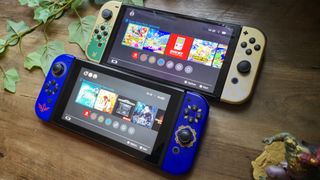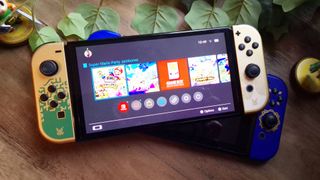The Allure of OLED: Why the Switch 2 Needs to Dazzle at Launch
As anticipation builds for the Nintendo Switch successor, fans are buzzing with excitement and speculation. Every hint or rumor ignites a spark of hope, especially when it comes to potential hardware enhancements. While the prospect of double the RAM is tantalizing, it’s the display that truly piques my interest. Any notion of sticking with an LCD screen in 2024 feels like a missed opportunity for Nintendo—a chance to redefine handheld gaming.
An Upgrade Worth Waiting For
Recent reports indicate that the upcoming console may feature an 8-inch LCD display, according to analyst Hiroshi Hayase’s comments shared via Bloomberg. This information has not yet been confirmed by Nintendo but does raise questions about the direction they may take with the next iteration of their beloved handheld.
 Anticipation grows for the next-gen gaming handheld.
Anticipation grows for the next-gen gaming handheld.
With an ever-expanding library of visually impressive games like Super Mario Odyssey and Splatoon 2, the original 6.2-inch LCD panel certainly did its job well. Yet, our gaming landscape has shifted, and with it, expectations have evolved. The remarkable transition to an OLED display in the revamped model signaled a monumental step forward, one that I didn’t fully appreciate until I made the switch for my Tears of the Kingdom themed console.
Why OLED Reigns Supreme
Once you make the switch to OLED, the contrast is hard to ignore. Tears of the Kingdom, regardless of the console you own, looks breathtaking. However, on an OLED screen, the vivid colors truly pop; Link’s green attire becomes vibrant, while the enchanting world of Hyrule bursts with life. Games played on an OLED display become more than just a pastime; they elevate the experience, drawing you deeper into the gameplay.
The signature saturation of the OLED screen enhances every pixel, transforming even the most mundane setups into spectacular views. The clarity it offers becomes a measuring stick against which all other displays are judged. Looking back at the LCD Switch feels like wrestling with nostalgia—wonderful, yet wholly inadequate compared to the stunning experiences offered by newer technology.
Will the Switch 2 Compete?
When it comes to handheld gaming, Nintendo has consistently prioritized affordability without sacrificing the quality of its first-party titles. The original Switch was a budget-friendly alternative to the likes of PlayStation 4, which launched at $399. Nintendo’s strategy has always involved delaying significant upgrades until later in the console’s lifecycle, letting them fine-tune their offerings based on consumer feedback.
This approach paid off with the launch of the Nintendo 3DS and its subsequent iterations. The original model came equipped with a less-than-perfect screen that was remedied only with later designs. Similarly, it has become clear that if Nintendo is to maintain its reputation, the Switch 2 must step up—and stepping up means offering an OLED screen right out of the gate.
 Could the Switch 2 be the ultimate handheld gaming device?
Could the Switch 2 be the ultimate handheld gaming device?
Handheld gaming technology is evolving, as seen with the Steam Deck, which adopted OLED shortly after its initial LCD model launch. There’s no doubt that players have come to expect these advancements, and the urge to experience the latest games in all their glory will only intensify.
The Price of Progress
Of course, the appeal of premium technology does not come cheap. Nintendo has succeeded in striking a balance between cost and performance, but a switch to OLED will likely increase production costs. However, I believe many gamers—myself included—are ready to pay that price for an enhanced experience.
As a lifelong Nintendo fan, my budget indeed shapes my choices. But if that means waiting for the OLED version of the Switch 2, I will gladly hold off for a future upgrade. Better technology is worth the wait.
 The future of handheld gaming is bright, but will it be vibrant enough?
The future of handheld gaming is bright, but will it be vibrant enough?
Surely, Nintendo recognizes that an OLED screen is not just a luxury; it’s a necessity for the next generation of gamers defined by portable experiences. If the Switch 2 launches with only an LCD display, many may indeed choose to hold out for the inevitable OLED upgrade—waiting for something greater in both performance and visual fidelity.
In conclusion, if Nintendo wants to meet the expectations of its fanbase, they must embrace OLED technology for the Switch 2 at launch. Anything less may result in disappointed fans, restless with the desire for the best gaming experience available. After all, the magic of handheld gaming has always been about immersion and enjoyment—elements brought to life through stunning visuals.
Let’s see if Nintendo takes this golden opportunity to create something truly exceptional with the upcoming Switch 2.


 Photo by
Photo by 












